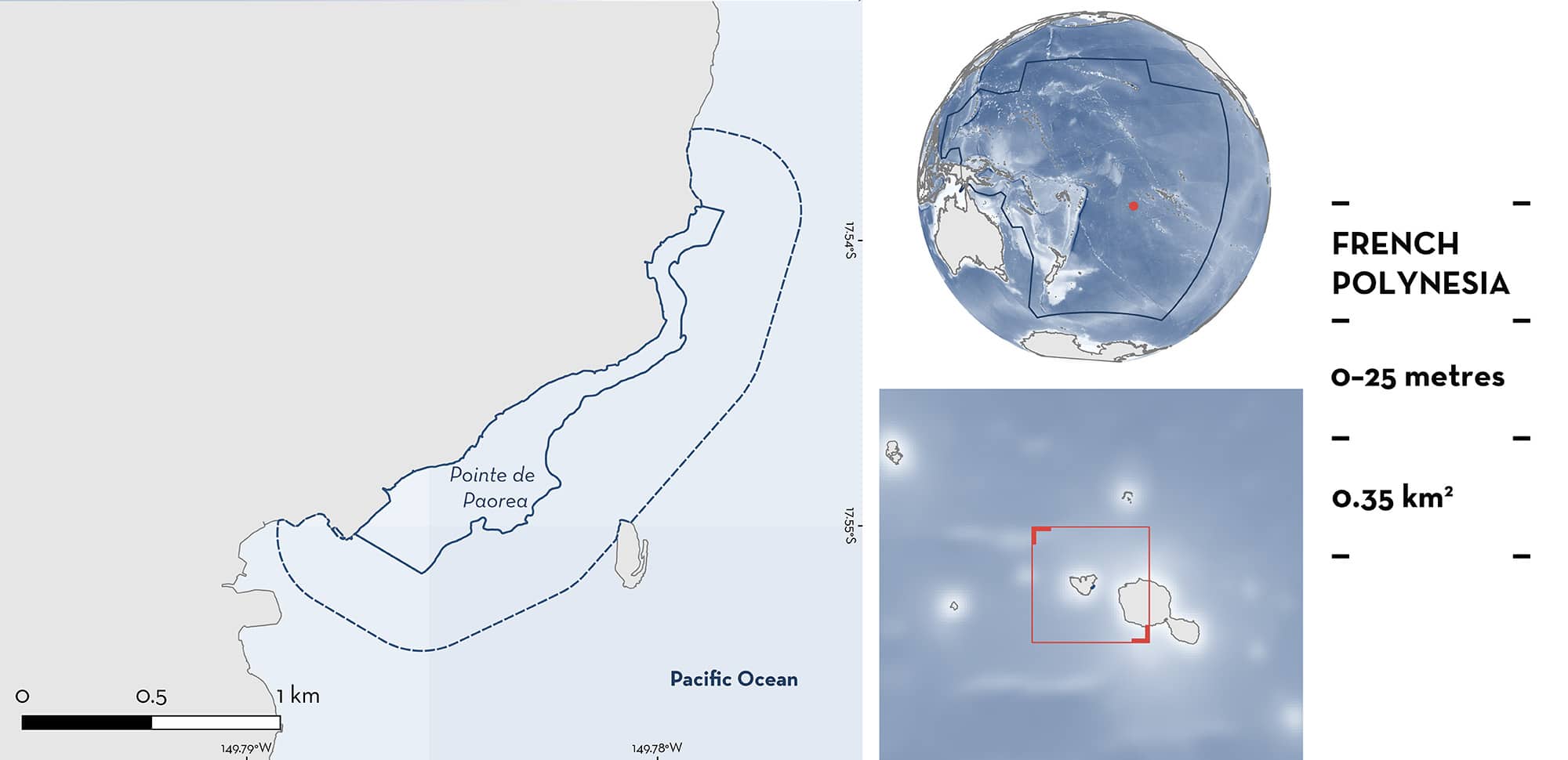ISRA FACTSHEETS
ISRA FACTSHEETS
NEW ZEALAND & PACIFIC ISLANDS REGION
Pointe de Paorea
Summary
Pointe de Paorea is situated on the southeast side of Moorea Island in the Society Archipelago of French Polynesia. The area encompasses a fringing reef bordering a small lagoon. Pointe de Paorea is characterised by a homogenous mix of corals, muddy and sandy substrates, and is influenced by low tidal variation. This area overlaps with the Lagon de Moorea Ramsar site and the Tetiaroa, Moorea et Tahiti marine Key Biodiversity Area. Within this area there are: threatened species and reproductive areas (Blacktip Reef Shark Carcharhinus melanopterus).
Download factsheet
Pointe de Paorea
DESCRIPTION OF HABITAT
Pointe de Paorea is situated on the southeast side of Moorea Island in the Society Archipelago of French Polynesia. The area is located within Moorea’s narrow lagoon system and encompasses a fringing reef forming a reef plateau, and a portion of a narrow lagoon connected with the open ocean. Pointe de Paorea is characterised by a homogenous mix of corals, and muddy and sandy substrates at depths <2 m within 50 m of shore (Bouyoucos et al. 2023; Eustache et al. 2024). The area is influenced by low tidal variation (~20–30 cm) (Bouyoucos et al. 2023) and currents generally oriented from the reef crest towards the channel, largely induced by waves (Ramsar Convention 2008; Berthe et al. 2018).
This area overlaps with the Lagon de Moorea site (Ramsar Convention 2008) and the Tetiaroa, Moorea et Tahiti marine Key Biodiversity Area (KBA 2024).
This Important Shark and Ray Area is benthopelagic and is delineated from inshore and surface waters (0 m) to 25 m based on the bathymetry of the area.
CRITERION A
VULNERABILITY
One Qualifying Species considered threatened with extinction according to the IUCN Red List of Threatened Species regularly occurs in the area. This is the Vulnerable Blacktip Reef Shark (Simpfendorfer et al. 2020).
CRITERION C
SUB-CRITERION C1 – REPRODUCTIVE AREAS
Pointe de Paorea is an important reproductive area for one shark species.
Between 2013–2022, a fisheries-independent program was conducted at ten sites around Moorea, including the area (Bouyoucos et al. 2023; Eustache et al. 2024). The area was sampled twice per month, between October and February using a monofilament gillnet (50 m x 1.5 m, with a 5 cm mesh size) set perpendicular to the shore for approximately three hours in the evening. Captured animals were fin-clipped, sexed, measured, weighed, and had their umbilical scars photographed with a size reference. The sharks sampled were identified as neonates or young-of-the-year (YOY) based on the healing stage of the umbilical scar and length size (Bouyoucos et al. 2023; Eustache et al. 2024). Size-at-birth for this species is 30–52 cm TL (Ebert et al. 2021). Fishing survey data were used to quantify catch-per-unit-effort (CPUE, sharks h-1) per gillnet set per site and per survey year (Bouyoucos et al. 2023; Eustache et al. 2024). These CPUE data were then used to determine if any of the 10 sites were shark nurseries, against respective criteria (Bouyoucos et al. 2023) to identify which of the 10 sites function as shark nursery areas (Heupel et al. 2007).
Between 2013–2022, ∼197 neonate/YOY Blacktip Reef Sharks were captured in the area (Physioshark Lab unpubl. data 2024). The seasonal pattern for parturition occurs annually from October to February when neonates and YOY are captured (Mourier & Planes 2013). This area has been described as a nursery area for Blacktip Reef Shark (Bouyoucos et al. 2023), fulfilling the three nursery area criteria (Heupel et al. 2007) in 2018. Pointe de Paorea presented a higher abundance of neonates and YOY relative to the other ten sites in 2017 and 2018, with a mean CPUE of 1.1 sharks h−1 from 2015–2019 (Bouyoucos et al. 2023). Recaptures were recorded in 2015 (n = 1), 2017 (n = 10), and 2018 (n = 3) (Bouyoucos et al. 2023).
Individuals captured across the 10 sites in Moorea (n = 1,607) included 52.2% neonates (n = 839), which were 35 days old or younger, and 46.7% YOY (n = 751), which were older than 36 days (Physioshark Lab unpubl. data 2024). Adults of Blacktip Reef Shark accounted for only 1.1% (n = 17) of the total captures (Physioshark Lab unpubl. data 2024).
Pointe de Paorea is one of the several areas of importance for neonates and YOY Blacktip Reef Sharks that have been identified around Moorea (Mourier & Planes 2013; Bouyoucos et al. 2023; Eustache et al. 2024). The existence of several of these areas dispersed around the island is attributed to the small home ranges of neonatal Blacktip Reef Sharks in Moorea. Research using mark-recapture and acoustic telemetry has shown that these home ranges are the smallest documented for the species, likely due to the deep channels within Moorea’s lagoon and the fragmented habitat (Bouyoucos et al. 2020). Additionally, pregnant female Blacktip Reef Sharks exhibit philopatry, returning to the same nursery for each birthing event (Mourier & Planes 2013). These factors together explain the presence of multiple nursery areas or areas that are crucial for neonate and YOY Blacktip Reef Sharks in Moorea.
Download factsheet
SUBMIT A REQUEST
ISRA SPATIAL LAYER REQUEST
To make a request to download the ISRA Layer in either a GIS compatible Shapefile (.shp) or Google Earth compatible Keyhole Markup Language Zipped file (.kmz) please complete the following form. We will review your request and send the download details to you. We will endeavor to send you the requested files as soon as we can. However, please note that this is not an automated process, and before requests are responded to, they undergo internal review and authorization. As such, requests normally take 5–10 working days to process.
Should you have questions about the data or process, please do not hesitate to contact us.


